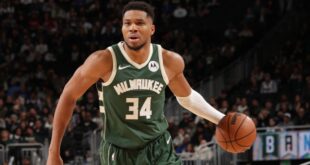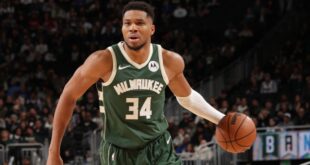**Editor’s Note:** For additional NBA analysis, check out more coverage from The Athletic here. The opinions expressed on this page may not represent those of the NBA or its teams.
* * *
With every exhilarating victory and each stride they take toward capturing the franchise’s inaugural NBA championship, the Indiana Pacers are gradually challenging our perceptions and methods of analyzing basketball.
For years, we’ve been accustomed to a particular template for identifying champions and exceptional teams, dictated by specific formulas and structures. A successful team typically requires at least one superstar, accompanied by a second high-caliber player capable of achieving All-NBA status. Additionally, there must be a reliable supporting cast around a few key players, ready to deliver in crucial moments. Even the 2011 Dallas Mavericks, despite their emphasis on collective success, relied on Dirk Nowitzki, whose playoff performance that year stands as one of the greatest individual displays in league history.
If the Pacers manage to convert their current 2-1 series advantage over the Oklahoma City Thunder into a title, they could emerge as the most unconventional champions since the 2004 Detroit Pistons. Notably, that Pistons squad boasted more star power, including the defensive prowess of Ben Wallace and the versatile playmaking of Chauncey Billups, along with four All-Star selections that season.
These Pacers aren’t constructed around superstars, though both Tyrese Haliburton and Pascal Siakam have surpassed expectations heading into the playoffs. Their strength lies in depth, versatility, and shooting, coupled with a legendary coach who has consistently outsmarted his opponents, round by round. They feature a roster full of players who can thrive in playoff scenarios — the distinction between merely having bodies on the court and deploying players who can make a genuine impact during the playoffs is significant. Their strategy revolves around relentless speed and tenacity, gradually wearing down opponents while making timely defensive stops.
Looking back in five or ten years, this Pacers run will have lasting significance, regardless of whether they secure a championship, as it exemplifies a new methodology for team-building in the post-CBA era. The era of championship teams dominated by a few star players is fading. This season has demonstrated through the Pacers and Thunder, as well as the Celtics last season, that the path to success now requires robust depth.
However, our unfamiliarity with the Pacers has led to them being labeled as underdogs. This series has been characterized as a David versus Goliath matchup. With the Pacers taking two out of the first three games, terms like “plucky” have emerged, reminiscent of Myles Turner’s physicality against Chet Holmgren in the closing moments of Game 3.
We need to reevaluate this perspective and acknowledge the reality.
The Oklahoma City Thunder possess the capability to turn the tide and win this series. They concluded the regular season with an impressive 68 victories and demonstrated their prowess during the playoffs by easily advancing through the Western Conference, facing only minor opposition from the Denver Nuggets.
Nonetheless, the dynamics of this series don’t negate the truth that both teams are exceptional: the Thunder are undeniable basketball titans, and so are the Pacers. We must adjust our thinking to see this series as a clash of two outstanding teams, both capable of extending the series to six or seven games, rather than viewing it as an elite squad facing a significant underdog.
This is not reminiscent of Villanova’s victory over Georgetown in 1985 or Jim Valvano’s 1983 North Carolina State team overcoming the Houston Cougars.
Perhaps the odds reflect such a narrative in Las Vegas, but the on-court performance of the Pacers suggests otherwise.
I understand the inclination to frame things this way, as adapting to change takes time, especially within basketball circles. It took us several years to recognize the greatness of Stephen Curry.
Furthermore, the Pacers didn’t provide much reason for attention in the season’s first two months, starting with a 10-15 record in their opening 25 games. Such a sample size often leads to teams slipping from the spotlight, particularly with the Cleveland Cavaliers showcasing a formidable regular season. However, since that rough start, the Pacers have turned things around to an impressive 54-22 record. They also posted a solid 12-4 in the playoffs’ first three rounds, clearly demonstrating their dominance by controlling an entire conference throughout postseason play.
The Pacers evolved into a formidable regular-season team, and they have transformed into an elite playoff contender. Haliburton and Siakam have established themselves as All-Star caliber players, excelling even more in high-pressure situations. Examining them closely reveals that they meet all the criteria one seeks in a potential champion.
You need strong defenders at the point of attack to combat the league’s guard play: Andrew Nembhard excels in that role.
An elite wing defender capable of effectively switching across matchups is essential: Aaron Nesmith has grown into this role after an uneven start to his NBA career with the Celtics.
A unique shooting big man with rim protection skills is essential, and Turner fits that prototype.
Consistent shooting throughout the rotation is critical: aside from T.J. McConnell, the Pacers do not put a subpar 3-point shooter on the court. Even McConnell is valuable with his ability to penetrate defenses.
Ideally, having scoring power coming off the bench is crucial. Bennedict Mathurin’s 27-point performance dramatically altered the course of Game 3. Additionally, the Pacers’ collective athleticism often goes unmentioned, yet it stands out even against an elite team like Oklahoma City.
The Pacers rightfully earned their title as the top team in the Eastern Conference this year, as their talent was evident. However, they have developed into a cohesive unit on both offense and defense. They have remained relatively injury-free, and the confidence gained from reaching the Eastern Conference finals last year has clearly translated into their current playoff performance. Offensively, they consistently push the pace, generate open shots, and convert those opportunities. Defensively, they have proven to be tough to break down. That’s why they find themselves just two wins away from an NBA championship.
Whether or not they achieve that goal, they should not be viewed as underdogs. With hindsight, the 2011 Mavericks team that Pacers head coach Rick Carlisle led to victory was not an underdog, either. We should recognize the Pacers — as well as the Thunder — for their strengths rather than framing Indiana as an unlikely contender.
The Indiana Pacers are a powerhouse, and it’s time we acknowledge them as such.
***
Tony Jones is a Staff Writer at The Athletic covering the Utah Jazz and the NBA. Hailing from the East Coast and having grown up immersed in journalism, he is a fan of hip-hop culture and pickup basketball. His Twitter account often features debates around Biggie and Tupac. Follow Tony on Twitter @Tjonesonthenba.
 NBA News NBA News, Match Reports and Updates
NBA News NBA News, Match Reports and Updates



